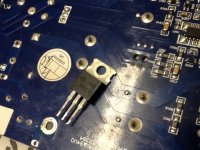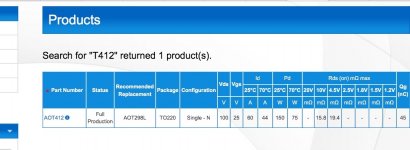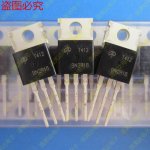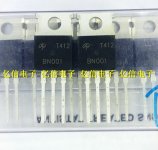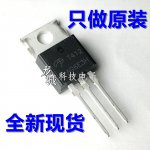BV5C11, N-E-MOS, C=3.45nF, Vt=4.0v, Uf=534mv as identified by a GM328A tester I got from China.
It's one of 4 being used for synchronous rectification in a SMPS providing +32 & -32 volt rails for 16 channels of Class-D amplification. One has gone short circuit D-S.
Incredibly, there is no information whatsoever on the net, I even looked up manufacturer logos (you'd be amazed how many there are just under A) and cannot identify the marking on this device.
This product is currently still in production. This specimen is not more than 3-4 years old.
Can anyone help? Or suggest a suitable replacement? I would replace all 4. Spec sheet for amp claims a rated wattage per channel of 30 into 8, all channels (16) driven & 40 into 4 - this gives some idea of current requirement.
Sorry about the poor quality of the photo. In case it helps, the logo looks like a capital A, sloping to the right, left leg shorter than the right, a half circle starting at the left leg and extending up and over the device to the right.
It's one of 4 being used for synchronous rectification in a SMPS providing +32 & -32 volt rails for 16 channels of Class-D amplification. One has gone short circuit D-S.
Incredibly, there is no information whatsoever on the net, I even looked up manufacturer logos (you'd be amazed how many there are just under A) and cannot identify the marking on this device.
This product is currently still in production. This specimen is not more than 3-4 years old.
Can anyone help? Or suggest a suitable replacement? I would replace all 4. Spec sheet for amp claims a rated wattage per channel of 30 into 8, all channels (16) driven & 40 into 4 - this gives some idea of current requirement.
Sorry about the poor quality of the photo. In case it helps, the logo looks like a capital A, sloping to the right, left leg shorter than the right, a half circle starting at the left leg and extending up and over the device to the right.
Attachments
Last edited:
The logo is Alpha and Omega. Here's their MOSFET selection page : Alpha & Omega Semiconductor
Judging by the capacitance I'd guess at AOT2606L. But 60V might be a bit low breakdown voltage in this application.
Judging by the capacitance I'd guess at AOT2606L. But 60V might be a bit low breakdown voltage in this application.
The logo is Alpha and Omega. Here's their MOSFET selection page : Alpha & Omega Semiconductor
Judging by the capacitance I'd guess at AOT2606L. But 60V might be a bit low breakdown voltage in this application.
Thanks so much, I will check this out immediatly
Searching T412 on the A&O site (link you provided) yields the screen capture below. Looks like my device  Yes?
Yes?
Searching the BV number yields nothing. Who would have thought? And I did try a Google search of T412 when I started looking yesterday....nothing.
Thanks again.
Searching the BV number yields nothing. Who would have thought? And I did try a Google search of T412 when I started looking yesterday....nothing.
Thanks again.
Attachments
T412 is a date/packaging plant codeSearching T412 on the A&O site (link you provided) yields the screen capture below. Looks like my deviceYes?
Searching the BV number yields nothing. Who would have thought? And I did try a Google search of T412 when I started looking yesterday....nothing.
Thanks again.
T412 is a date/packaging plant code
No it isn't, that's what I thought too. It's part of the part number. Being 'part' of the part number, it didn't come up in a Google search.
I searched for AOT412 on Taobao, here is a typical pic:
Thanks, you solved the problem with your first post. As soon as I had the link, and I realised T412 was the shortened part number, I had the datasheet from the A&O site. From there it was only minutes to finding a Chinese vendor, in my case on Ali.
Thanks everyone for your input, I should maybe have been clearer about the question having been fully and satisfactorily answered. I didn't post the datasheet because I don't know how to do it with an iPad.
I live in a Third World country. Going by recent experience, it's going to take between 3 and 6 months for the parts to get here - about a week for Chinese to do their bit and the balance for the 'locals' to 'handle' my package (a padded envelope at most). Sooo.... If anyone can think of a suitable Mosfet from a different manufacturer, something I might be able to get locally, I'm all ears
Thanks, yes, it was on the A&O site but it is nice that you post the link for others to find it.
Apart from being broken
......now I can't this damn part out of my head and worse still, I have to decide which vendor to buy it from.
Attached are two images of T412 taken from the net. Bear in mind the photo I attached in post # 1 is of an original (one would assume authentic) device.
Notice that the metal tag is notched again at each top corner - effectively removing the corner. This is unusual, at least in my experience. Notice also there are no 'eject' marks on the resin body. It is completely smooth. What does not show in the photo is there is a shaded rectangle centred on the resin body. Then there is a 6 character code on the lower portion.
The attached images in this post don't have the same metal tab and they have also 'eject' markings on the casing, and in different places. Then the codes are not both 6 characters. Does this matter? Are the devices counterfeit? I have seen counterfeit devices that look way better than original authentic devices - these are actually a case in point.
Attached are two images of T412 taken from the net. Bear in mind the photo I attached in post # 1 is of an original (one would assume authentic) device.
Notice that the metal tag is notched again at each top corner - effectively removing the corner. This is unusual, at least in my experience. Notice also there are no 'eject' marks on the resin body. It is completely smooth. What does not show in the photo is there is a shaded rectangle centred on the resin body. Then there is a 6 character code on the lower portion.
The attached images in this post don't have the same metal tab and they have also 'eject' markings on the casing, and in different places. Then the codes are not both 6 characters. Does this matter? Are the devices counterfeit? I have seen counterfeit devices that look way better than original authentic devices - these are actually a case in point.
Attachments
Last edited:
It is rare to find a mosfet that is really that much better than its competitors. Either the parameters are being measured at different conditions ( a common issue) or the 60A rating is being very ambitious - maybe why it blew in the first place....this seems to be quite a capable device with very low input, output and reverse transfer capacitance figures, and also very low Qrr. I looked through about 15 datasheets so far for devices that can satisfy the 100v / 60A requirement and they mostly have up to triple figures for the capacitance....
Apart from being brokenthis seems to be quite a capable device with very low input, output and reverse transfer capacitance figures, and also very low Qrr. I looked through about 15 datasheets so far for devices that can satisfy the 100v / 60A requirement and they mostly have up to triple figures for the capacitance. The device is being indirectly driven (there are some Sot23 devices around the gates) by a TL494. There is one other parameter which is 25v (Vgs I think) and all the others are lower 16 - 20v). If you know of anything that might sub here, please do share.
Mouser's a very good resource for such exercises, I punched in 100V and above 30A and TO-220 (beware, there are many variants) and the one which bubbled to the top from a search ordered on lowest gate charge was this one :
http://www.ti.com/lit/ds/symlink/csd19534kcs.pdf
About 10% lower current for sure but do you need all those 60 amps? The capacitance is considerably improved - look at the gate charge plot, its 17nC vs 45nC.
- Status
- This old topic is closed. If you want to reopen this topic, contact a moderator using the "Report Post" button.
- Home
- Design & Build
- Parts
- Anyone recognise this mosfet or the logo?
